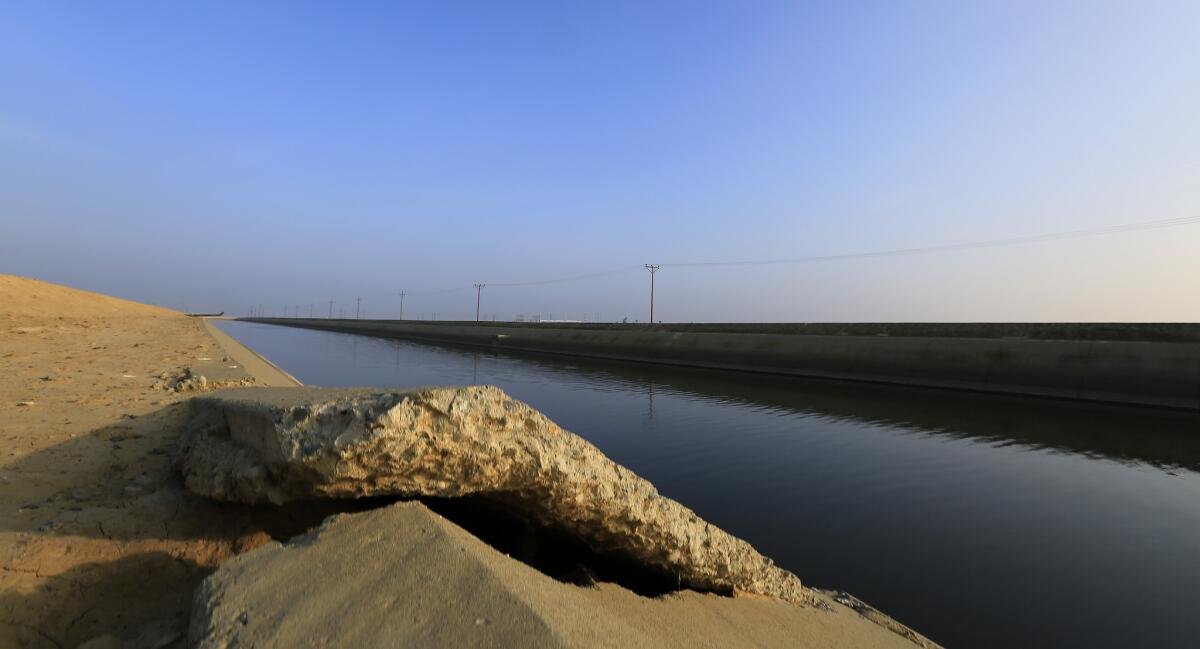21 California groundwater basins in ‘critical’ condition, state panel says

Many of the groundwater basins in the San Joaquin Valley are stressed, according to a new state report. Above, cracked concrete on the Delta Mendota Canal near Los Banos, where the land is sinking.
- Share via
State officials on Wednesday released a list of California groundwater basins that have been the most severely depleted by pumping, with the San Joaquin Valley suffering the most but a few areas in Southern California also heavily affected.
The list of 21 basins and sub-basins suffer from what the state deems “critical overdraft,” a condition in which significantly more water has been taken out of a basin than has been put in.
“This is one snapshot of some significant issues we’re facing and everybody’s got to come together ... move forward and fix them,” Lauren Bisnett, a spokeswoman for the state Department of Water Resources, said Wednesday.
In the state’s fourth year of drought, Californians in need of water have increasingly turned to groundwater, digging deeper and deeper wells as other supplies run dry.
But overdraft can cause the land to gradually sink. A NASA report also released Wednesday showed that pumping too much groundwater has caused land in some parts of the San Joaquin Valley to subside faster than ever.
Wednesday’s updated list paints a comprehensive picture of the areas where the state’s groundwater crisis is most acute. The vast majority of the basins lie beneath the central part of the state, in cities and towns stretching from Bakersfield to Merced, according to the state’s report — the same places where the land is sinking.
The report also pointed to several troubled basins in Southern California. Aquifers beneath parts of Oxnard and Pleasant Valley in Ventura County, the Cuyama Valley near Santa Barbara and the Borrego Valley in San Diego and Imperial counties were on the state’s list.
“We’ve been experiencing impacts [of overdrafting] for some time. They’re not going away overnight,” Bisnett said. “But this list does help us focus. How we manage and recharge those basins really makes this important.”
Wednesday’s announcement represents the first update to the state’s list of critically overdrafted basins since 1980, said Mary Scruggs, supervising engineering geologist with the water department. New data and comments by local agencies could cause the list to change in the coming weeks, officials said.
Although the state issued an updated report on groundwater in 2003, the Department of Water Resources did not have enough funding to update its list, Scruggs said. The package of historic groundwater management laws enacted by Gov. Jerry Brown last fall provided the money for Wednesday’s update, she added.
Under the new groundwater laws, basins that are identified as critically overdrafted must have sustainability plans in place by 2020. Other basis have an extra two years before they are required to adopt their management plans.
The final list of critically overdrafted basins is expected to be released in October.
Twitter: @ByMattStevens
More to Read
Sign up for Essential California
The most important California stories and recommendations in your inbox every morning.
You may occasionally receive promotional content from the Los Angeles Times.











